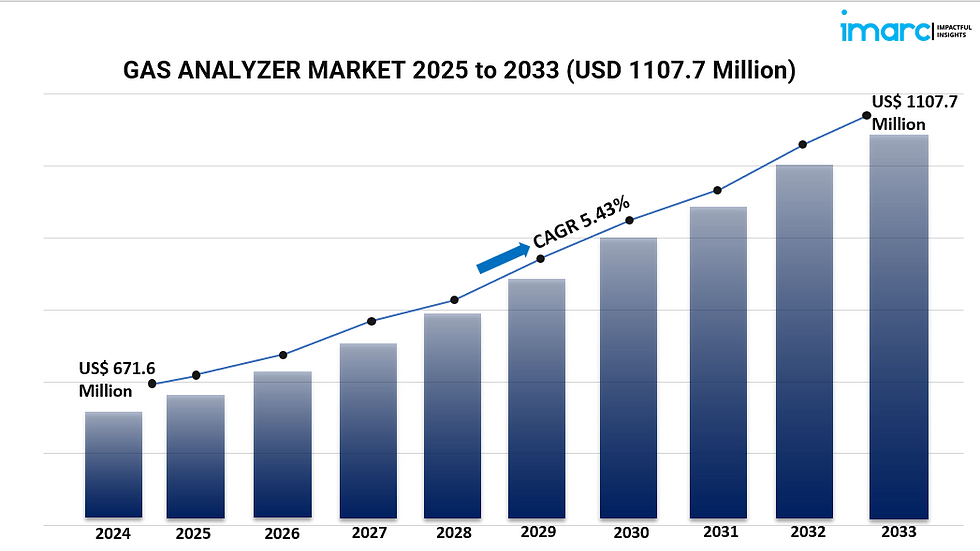Emerging Opportunities in the Global 6G Market: Trends, Growth, and Future Outlook 2025-2033
- Rahul Pal
- Sep 26
- 4 min read

MARKET OVERVIEW
The global 6G market is experiencing exponential growth, fueled by the demand for ultra-reliable, low-latency networks that support AI, IoT, AR/VR, and smart city initiatives. Rapid technological innovations, coupled with government initiatives and significant R&D investments, are driving market expansion. The market is projected to grow from USD 275.5 million in 2024 to USD 30,170.65 million by 2033, registering a CAGR of 63.50%, transforming connectivity across industries.
STUDY ASSUMPTION YEARS
Base Year: 2024
Historical Year: 2019–2024
Forecast Year: 2025–2033
6G MARKET KEY TAKEAWAYS
Market Size & Growth: USD 275.5 million in 2024; expected to reach USD 30,170.65 million by 2033 at a CAGR of 63.50%.
Regional Leader: Asia Pacific dominates the market in 2024 due to strong R&D and digital infrastructure investments.
Technological Drivers: Adoption of terahertz frequencies, AI-enabled networks, and quantum computing is boosting growth.
Government & Private Investments: National initiatives and collaborations accelerate infrastructure development and innovation.
Advanced Applications: Rising demand for autonomous vehicles, industrial automation, telemedicine, and AR/VR drives market adoption.
Market Segmentation: Hardware, software, and services segments are expanding, with hardware expected to lead.
Request for a sample copy of this report: https://www.imarcgroup.com/6g-market-report/requestsample
MARKET GROWTH FACTORS
Technological Advancements
6G technology is transforming connectivity with ultra-high-speed networks, low latency, and extensive data handling capabilities. Terahertz frequency bands combined with AI-driven network management enable intelligent communication, optimizing traffic flow and reliability. Hardware innovations, including energy-efficient chips and advanced antenna systems, further enhance performance. Integration with quantum computing allows unprecedented processing speeds, supporting real-time AR/VR, autonomous vehicles, and industrial automation. Continuous R&D investments ensure rapid technological evolution, providing seamless global connectivity, improved network efficiency, and scalability. Adoption of 6G in smart cities and IoT ecosystems highlights the technology's transformative impact on communication infrastructure, driving substantial market growth.
Regulatory & Government Support
Government initiatives and regulatory frameworks play a critical role in accelerating 6G adoption. Policies across the US, China, and Europe focus on funding research, developing digital infrastructure, and fostering international collaborations. Public-private partnerships with technology firms and academic institutions expedite innovation and standardization efforts. Regulatory emphasis on energy efficiency, network security, and spectrum allocation ensures safe and sustainable deployment. For instance, the US-Sweden joint 6G research emphasizes interoperability and environmental impact mitigation. These structured efforts encourage private enterprises to invest in advanced 6G technologies while maintaining global competitiveness, reinforcing market expansion.
Rising Demand for Advanced Applications
The growing requirement for ultra-reliable, low-latency networks is driving 6G adoption across industries. Applications such as autonomous vehicles, smart factories, telemedicine, and immersive AR/VR experiences demand seamless data transfer with minimal latency. The proliferation of IoT devices and real-time analytics in smart cities further amplifies demand. Collaborations like SK Telecom and Intel’s development of Inline Service Mesh technology have reduced communication delays by up to 70%, enhancing network efficiency. The integration of AI, IoT, and high-speed communication within 6G infrastructure enables innovative services, expanding market opportunities and accelerating global deployment.
MARKET SEGMENTATION
By Component:
Hardware: Physical infrastructure including chips, antennas, and network devices essential for 6G deployment.
Software: Network management, AI algorithms, and protocols ensuring adaptive and efficient operation.
Services: Installation, maintenance, and consulting facilitating deployment and optimization of 6G networks.
By Communication Infrastructure:
Terrestrial Networks: Ground-based infrastructure providing connectivity for urban and rural areas.
Satellite Networks: Space-based communication networks enhancing coverage and enabling global connectivity.
By Usage Scenario:
Enhanced Mobile Broadband: High-speed wireless access supporting AR/VR, video streaming, and cloud services.
Ultra-Reliable Low Latency Communications: Networks enabling real-time communication for autonomous systems and industrial automation.
Massive Machine-Type Communications: Connectivity supporting IoT devices and smart city applications.
By End-User:
Automotive: Enabling connected and autonomous vehicles with low-latency communication.
Healthcare: Supporting telemedicine, remote monitoring, and advanced diagnostics.
Industrial Automation: Facilitating smart manufacturing, robotics, and predictive maintenance.
Smart Cities: Infrastructure for traffic management, surveillance, and public services.
Others: Various sectors adopting 6G for high-speed connectivity solutions.
Breakup by Region:
North America (United States, Canada)
Asia Pacific (China, Japan, India, South Korea, Australia, Indonesia, Others)
Europe (Germany, France, United Kingdom, Italy, Spain, Russia, Others)
Latin America (Brazil, Mexico, Others)
Middle East and Africa
REGIONAL INSIGHTS
Asia Pacific leads the 6G market in 2024, driven by rapid technological advancements, high R&D investments, government support for digital infrastructure, and increased adoption of AI, IoT, and smart city solutions.
RECENT DEVELOPMENTS & NEWS
Key developments include China Mobile’s launch of the world’s first 6G satellites in February 2024 and SK Telecom’s collaboration with Intel to reduce core network latency by 70% using AI-enabled processors. The 6G Conference in Istanbul highlighted standardization and innovation initiatives, including ITU-R’s 6G framework and upcoming 3GPP standardization in 2025. These efforts emphasize global focus on ultra-reliable, low-latency communication, supporting autonomous vehicles, industrial automation, telemedicine, and AR/VR, while enabling sustainable, energy-efficient high-speed networks.
KEY PLAYERS
AT&T Intellectual Property
Huawei Technologies Co., Ltd.
Intel Corporation
Jio Platforms Ltd
Keysight Technologies
Nokia Corporation
NTT Docomo
Samsung Electronics Co., Ltd.
Telefonaktiebolaget LM Ericsson
If you require any specific information that is not covered currently within the scope of the report, we will provide the same as a part of the customization.
Ask Analyst for Customization: https://www.imarcgroup.com/request?type=report&id=25613&flag=C
About Us:
IMARC Group is a global management consulting firm that helps the world’s most ambitious changemakers to create a lasting impact. The company provides a comprehensive suite of market entry and expansion services, including market assessment, feasibility studies, company incorporation assistance, factory setup support, regulatory approvals, branding, marketing strategies, benchmarking analyses, pricing research, and procurement research.
Contact Us:
IMARC Group134 N 4th St. Brooklyn, NY 11249, USA
Email: sales@imarcgroup.com
Tel No: (D) +91 120 433 0800
United States: +1-201971-6302






Comments